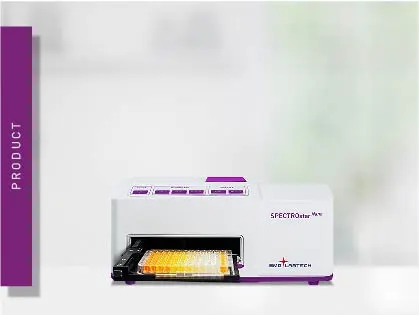
SPECTROstar Nano
Absorbance plate reader with cuvette port
Viruses, nowadays more than ever, pose growing threats to our health, society, and economy. Virus assays suitable for analysing the mechanisms behind virus infections as well as quantifying related diagnostic parameters are key in understanding virus-host interactions and virus pathophysiology1. In this regard, 50% Tissue Culture Infectious Dose (TCID50) assays are often used to quantify virus titers and are an important tool for the determination of virus infectivity and replication, both crucial parameters for the assessment and investigation of new treatments and therapeutics.
 Dr Martin Mangold
Dr Martin Mangold
Viruses are intracellular pathogens that can infect all living organisms, although the types of cells that a virus can infect (called host range) are generally limited and specific2. Since the viral genome encodes only a small number of proteins, viral pathogens rely on and exploit the cellular mechanisms of a host cell to enable their replication and spread. In order to develop new treatment strategies and drugs, it is essential to understand and therefore study the interactions between virus and host cell and to determine virus infectivity, e.g., by TCID50 assays.
Generally, the viral life cycle and possible interactions can be assigned to six basic stages (figure 1). In the first stage, a virus particle (virion) attaches to the membrane surface of a host cell via the interaction of a viral surface protein with a host receptor molecule. After attachment, the virion enters the host cell through endocytosis or membrane fusion. Arrived inside the host cell, the virus capsid is removed releasing the viral genome. Subsequently, the viral genome and proteins are multiplied by transcription and translation using the machineries of the host cells. In the fifth step, new virions are assembled from the post-transcriptionally modified virus proteins and replicated genetic material. Finally, these virions are released from the host via budding, exocytosis or after the cell lysis.
The efficiency of the entire viral life cycle determines its infectivity and specificity toward a host organism 3. Each step offers opportunities to interfere with the virus-host interactions and to block or reduce virus replication. The 50% Tissue Culture Infectious Dose (TCID50) can be used to quantify and to assess the infectivity of a virus in cells. TCID50 assays are an important tool for the evaluation of anti-viral drugs, as they enable the investigation of the effect of drugs on the life cycle of a virus.
50% Tissue Culture Infectious Dose (TCID50) assays are virus titration experiments which can be used to quantify virus titers by investigating the cytopathic effects of a virus on an inoculated host cell culture4. Compared to the widely used plaque assays, which are also used in virus quantification, TCID50 assays offer the advantage that even viruses that do not form plaques or infect cell monolayers can be quantified.
In TCID50 assays, varying virus dilutions are added as an endpoint dilution to host cell populations with the same number of cells and incubated until a cytopathic effect can be seen. Here, the TCID50 value represents the amount of virus dilution required to induce cytopathic effects in 50% of wells containing the inoculated cell culture after a defined period of time.
TCID50 assays assess this threshold either by visually counting the number of affected wells or by using cell viability assays as readout. The TCID50value is determined when the cytopathic effect or cell viability assay read-out appear the same for a dilution in 3 separate readings. An example of the application of cell viability/toxicity assays for the evaluation of viral cytopathic effects can be found in the AN 363: Viral cytopathic effects measured in a drug discovery screen.
The results of 50% Tissue Culture Infectious Dose (TCID50) assays can be analysed by different calculations 5. Several mathematical approaches have been developed for this purpose, including the Reed-Muench 4, Spearman-Kärber or Weil method. The formula after Reed-Muench is depicted as an example below.

Where I is the interpolated value of the 50% endpoint and h is the dilution factor.
Since most often, the exact 50% endpoint is not observed in TCID50 assays, an approximate value can be obtained factoring in the dilutions closest below and above the 50% threshold. Independent of the method, the dilution at which 50% of the cell cultures are infected is determined and used to mathematically calculate a TCID50 result which is expressed as 50% infectious dose (ID50) per millilitre (ID50/mL) after a defined period of time. For example, if 0.2 mL of a 1:10,000 virus dilution infects 50% of the cells in 2 days the titer is expressed as 104 TCID50/0.2 mL in 2 days.
50% Tissue Culture Infectious Dose (TCID50) assays can be performed with a variety of readouts in comparison to plaque assays which relies on plaque formation. While traditionally, the wells which show a cytopathic effect are counted on a microscope or imager, microplate readers offer automated and sensitive approaches for the qualitative measurement of TCID50 assays using absorbance, fluorescence, or luminescence readouts. Most often, cell viability assays such as MTT or CellTiter-Glo® are used for this purpose, where drops in cell viability are monitored as indicator of cytopathic effects due to virus replication. Another way to assess the infectivity of a virus in a cell culture is by immunostaining for a viral antigen. Immunofluorescence can also be used as readout of TCID50 assays. Since the immunofluorescence staining of viral antigens offers overall a higher sensitivity than cell viability experiments, even infections that do not induce a strong cytopathic effect in cells can be detected.
The performance of virus quantification and infectivity experiments, such as 50% Tissue Culture Infectious Dose (TCID50) assays, on a microplate reader offers additional advantages in comparison to traditional techniques such as plaque assays, which often revolve around microscopy or gel-based methods. Small sample volumes and assay miniaturisation that can be achieved in a microplate, allow a faster and more straight forward sample preparation and handling. This usually also comes with a reduction in material and reagent costs. This advantage in TCID50 assays is particularly evident when compared to other endpoint assays, such as LD50 assays, which determine virus titres by 50% lethal dose in mouse specimens.
Due to the high biological variation of TCID50 assays, it is advised to include smaller dilution steps and higher number of replicates. This is easily achieved using the microplate format since a higher number of samples can be measured simultaneously on one device. Thus, a much higher throughput can be achieved which can be improved even further by the integration of microplate readers into automated systems. This is especially important for the high-throughput screening of new drug candidates or re-purposed drugs but also in diagnostic testing. Here, TCID50 assays offer a straightforward solution for the assessment of virus infectivity in cells and anti-viral effects.Additional features, such as enhanced dynamic range, well-scanning and internal atmospheric control available on BMG LABTECH plate readers such as the CLARIOstar®Plus and the VANTAstar® further expand your options for TCID50 assays.
In conclusion, microplate readers provide the perfect platform for the performance of TCID50 assays in low- as well as in high-throughput. The choice of detection modes, measurement settings, plate sizes and the option for integration into automated systems offered by microplate readers is key in this regard.
Are you interested in more virology content? Check out our virology research area section. Here you can find other blog posts, webinars, references on peer-reviewed papers and application notes covering this topic such as How to detect a virus with a microplate reader? or Studying the molecular mechanism of viral replication in real time using the CLARIOstar Plus with ACU.
Absorbance plate reader with cuvette port
Powerful and most sensitive HTS plate reader
Most flexible Plate Reader for Assay Development
Upgradeable single and multi-mode microplate reader series
Flexible microplate reader with simplified workflows
Gene reporter assays are sensitive and specific tools to study the regulation of gene expression. Learn about the different options available, their uses, and the benefits of running these types of assays on microplate readers.
This blog highlights some alternative viral detection methods to PCR. Find out, which can be run on microplate readers and what advantages the readout in microplates offers.
This blog article highlights different approaches on how microplate readers can be used for the detection of viruses. Read more here.
The dangerous viral outbreaks of recent years, such as SARS-CoV-2, illustrate the intensive research that virology requires. Find out more about available virus assays here.
Vaccines are powerful tools to fight viral diseases. Read more about the science behind vaccines and what we can expect from vaccine development in the future.